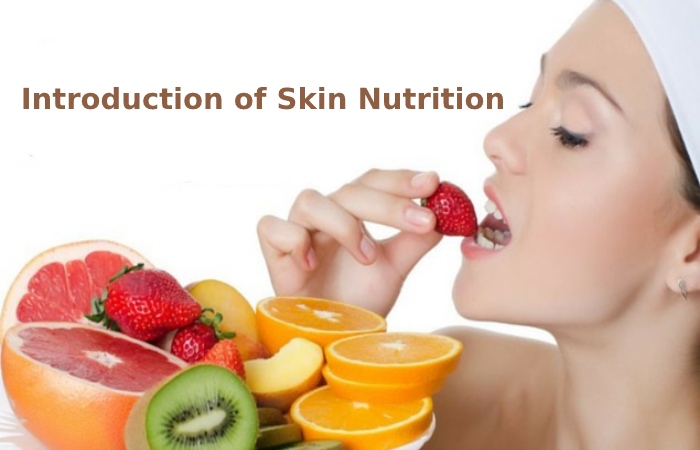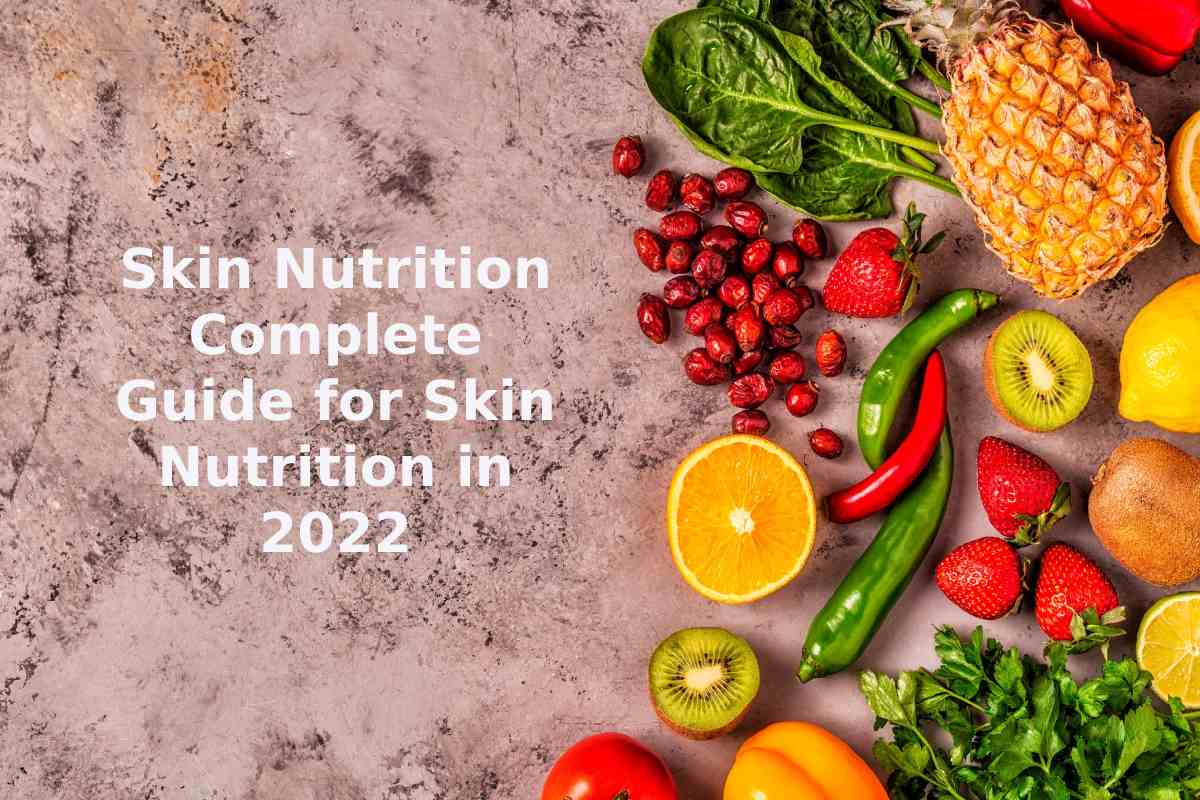Table of Contents
Definition of Skin Nutrition
Skin Nutrition is very important to keep your skin healthy and fresh, so eating sufficient antioxidants-fruits and vegetables is good for your entire body and your skin. Antioxidants like beta-carotene and vitamins C, E, and A can slow down the damage caused by unstable molecules known as free radicals. These molecules can damage skin cells and cause signs of aging.
Introduction of Skin Nutrition

Beauty comes from within. The connection between diet and skin condition, or the influence of diet on skin aging, has been an exciting area of research for scientists and an area of common interest for people since antiquity. Skin aging consists of two didactically self-governing, clinically, and biologically different processes.
- The first is intrinsic skin aging, which characterizes chronological aging and affects the skin in the same pattern as all internal organs.
- The second is the extrinsic aging of the skin, which we will describe below. It looks like aging skin and results from external and environmental factors, mainly chronic sun exposure and ultraviolet (UV) radiation, smoking, pollution, lack of sleep, and poor diet.
Prevention is the best and maximum effective way to counteract the external effects of skin aging. The best strategy to prevent the harmful effects of free radicals is a well-regulated lifestyle (calorie restriction, personal hygiene, and physical activity for the body) with little stress and a balanced diet that includes antioxidant foods.
It has often investigated antioxidants such as carotenoids, tocopherols, flavonoids, vitamins (A, C, D, and E), omega-3 essential fatty acids, some proteins, and lactobacilli are cited as active ingredients that can promote the health and beauty of the skin. 3, 4 to strike an appropriate balance, this review considers the beneficial “antiaging” effects of increased reactive oxygen species (ROS) signaling recently.
This paper examines existing literature and provides insight into whether diet influences how our skin ages.
Essential Vitamins for Skin
L-Ascorbic Acid (Vitamin C)
Vitamin C, called L-ascorbic acid, is water soluble, light sensitive, and the most important antioxidant in the hydrophilic phase. The human body does not logically synthesize vitamin C; therefore, adequate dietary intake of vitamin C is necessary for a fit human diet.
The richest natural causes are fresh fruits and vegetables such as citrus fruits, black currant, rose hips, guava, chili, or parsley. The vitamin C molecule’s stability depends on the aggregation state and preparation.
L-ascorbic acid can be used verbally and topically for skin profit. Vitamin C is a co-factor for lysyl and prolyl hydroxylases, stabilizing collagen’s triple helix structure. It also influences cholesterol synthesis and iron absorption and increases selenium bioavailability. The most frequently described skin symptoms associated with vitamin C deficiency are attributed to impaired collagen synthesis. Enlargement and keratoses of the hair follicles, especially on the upper arms, and curly hair, the so-called “corkscrew hairs, are usually described. In addition, the follicles become hemorrhagic over time, sometimes simulating the palpable purpura of leukocytoclastic vasculitis.
Tocopherols (Vitamin E)
The vitamin E complex is a collection of 8 compounds called tocopherols. Tocopherol is a fat-soluble, membrane-bound antioxidant and thus a scavenger of radicals, particularly highly reactive singlet oxygen. Like vitamin C, tocopherol is a natural endogenous non-enzymatic antioxidant.
Vitamin C and vitamin E work synergistically. When UV-activated bits oxidize cellular components, a chain reaction of lipid peroxidation is initiated in membranes rich in polyunsaturated fatty acids. For example, the antioxidant d-α-tocopherol is oxidized to the tocopherol radical, and ascorbic acid regenerates it to d-α-tocopherol. In addition to ascorbic acid, glutathione and coenzyme Q10 can also recycle tocopherol.
Carotenoids (Vitamin A, β-Carotene, Astaxanthin, Retinol)
Carotenoids are derivatives of vitamin A, such as β-carotene, astaxanthin, lycopene, and retinol, which are powerful antioxidants and have been shown to have photo-protective properties. The results of Scarfo et al. suggest that human skin is relatively rich in lycopene and β-carotene compared to lutein and zeaxanthin, possibly reflecting a specific role for hydrocarbon carotenoids in the photo-protection of human skin.
Vitamin D
In humans, vitamin D serves two tasks, it acts as a prohormone, and the human body can synthesize it on its own through sun exposure. The skin is the main site for UV-B mediate synthesis of vitamin D3 and 1, 25-dihydroxy vitamin D3. Smaller quantities of vitamin D2 and D3 come from dietary intake of animal foods such as fatty fish or egg yolks. In addition, some products, such as milk, cereals, and margarine, can be fortified with vitamin D.
Vitamin D is kept in body fat and can cause toxic effects. This toxicity presents nausea, vomiting, poor appetite, weakness, weight loss, and constipation. Food intake of vitamin D high enough to cause toxicity is highly unlikely.
Essential Fatty Acids (Vitamin F)
Essential fatty acids (EFAs) are long-chain polyunsaturated and derived from linoleic and oleic acids. They cannot be formed in the human body and must be ingested through daily food intake. Needed fatty acids are also known as vitamin F. Arachidonic acid is a semi-EFA because it can be manufactured in the body from linoleic acid. The two relations of EFAs are ω-3, derived from linolenic acid, and ω-6, derived from linoleic acid. The number indicates the position of the first double bond extending from the terminal methyl group of the molecule. They are present in various dietary sources such as fish and shellfish, flaxseed, hempseed oil, soybean oil, canola oil, chia, pumpkin, sunflower, green vegetables, walnuts, sesame seeds, avocados, salmon, and albacore tuna AGEs are essential for the mixture of tissue lipids, play a significant role in the regulation of cholesterol stages and are precursors of prostaglandins.
Essential fatty acids can also be found on the market as artificial supplements. For example, fish oil supplements are typically made from mackerel, herring, tuna, halibut, salmon, cod liver, fat, or seal blubber, are high in omega-3 fatty acids, and often contain small amounts of vitamin E. They can also be combined with calcium, iron, or vitamins A, B1, B2, B3, C, or D.
Caloric Restriction
It is well recognized that caloric restriction (CR) without malnutrition delays. The onset of aging and prolongs lifespan in various animal models, including yeast, worms, flies, and laboratory rodents. Although the underlying mechanisms are still unknown, some explanations exist. . Such as alterations in hormone metabolism, hormone-related cell signaling, oxidation state, DNA repair, apoptosis, and oncogene expression.
They are delayed or prevented by CR. Specifically, a trend toward higher levels of collagen and elastic fibers, fibroblasts, and capillaries and prevention of age-related increases in the depth of the epidermis, dermis, and adipose layer were observed in skin samples from CR rats.
In addition, A variety of differently expressed genes were shown in the skin tissues of CR weight control mice compared to mice fed a normal diet. The authors concluded that the CR diet showed a profound inhibitory effect on the expression of genes relevant to cancer risk. Studies are ongoing to evaluate CR in nonhuman primates and its impact on human health and metabolic parameters.
Importance of Skin Nutrition
Skin is one of the toughest indicators of health. Your skin is the fingerprint of what’s happening inside your body. All skin situations, from psoriasis to acne to age, are manifestations of your body’s internal needs, including your nutritional needs. Dr. Georgiana Donadio, Founder of the National Institute of Holistic Health.
Wrinkles, dry or oily skin, acne, and inflammation are signs of poor internal health, often caused by eating unhealthy foods and avoiding skin nutrition problems. As a result, most people turn to common topical cosmetics such as lotions, soaps, scrubs, toners, and creams to treat skin problems.
However, treating external blemishes with expensive. The chemical-laden beauty products does little to address the root of the problem. Which in most cases is poor diet and exposure to toxins in dietary and personal care products.
A recent study showed that the skin responds particularly well to certain vitamins, minerals, and antioxidants that nourish the skin and retain it young and healthy. The following nutrients are among the best for healthy, youthful-looking skin and result in a good skin nutrition score.
- Drink a daily minimum of 8-10 glasses of water [Full story: Health benefits of drinking water].
- Include fresh fruits and vegetables rich in vitamins C, A, and E in your daily diet. For example, oranges, sweet lime, amla, guava, spinach, lemon, etc. [Full story: Are fruits and vegetables fattening?].
- Nibble on almonds and walnuts for better skin quality.
- Avoid regular consumption of alcohol or smoking.
- Follow a healthy and regular routine of balanced diet and exercise. Read more about simple tips for a balanced diet.
- Get a regular 6 to 8 hours of sleep every day.
- A well-known saying is you are what you eat. What enters you is what reflects the outer skin.
Conclusion
In conclusion, nutrition and skin aging continues to be controversial and conflictive. A promising strategy for enhancing skin protection against oxidative stress is to support. The body’s antioxidant system with products containing antioxidants that are normally present in the skin. However, this should not be confused with long-term high-dose Physiologically High Antioxidants intake. Eating fruits and vegetables may be the healthiest and safest way to maintain a balanced diet and youthful-looking skin.

